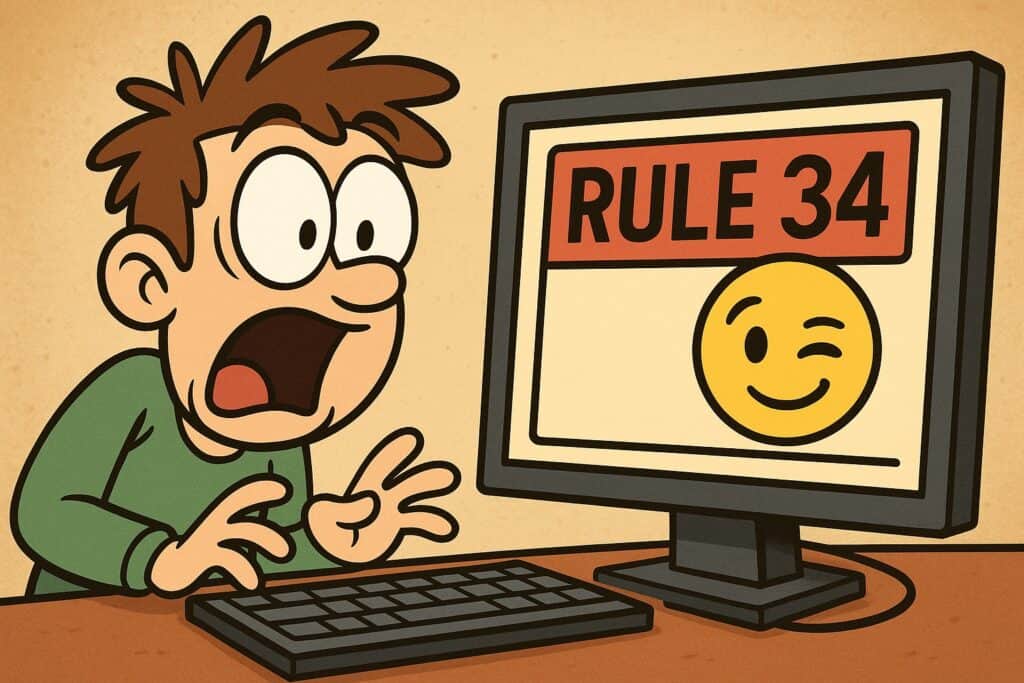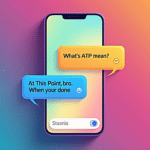So you’re scrolling through your feed, see a meme about your favorite cartoon character, and someone in the comments drops, “Rule 34 strikes again!”—cue a mix of laughter, confusion, and maybe a little shock. What’s the deal with Rule 34, and why does everyone act like it’s some kind of internet law? Let’s break it down, no jargon, just real talk—because this is one of those things that’s wilder than it sounds. 😏👀
| What is Rule 34? | Where did it come from? | Is it serious or a joke? | Why does it matter? |
|---|---|---|---|
| “If it exists, there’s porn of it—no exceptions” | Early 2000s internet forums and memes | Both! Humorous, but real | Highlights internet creativity, raises ethical questions |
What Exactly Is Rule 34?
Rule 34 is one of the internet’s most famous “rules,” and it’s as simple as it is shocking: If it exists, there is porn of it. No exceptions.
That means anything—cartoons, celebrities, video game characters, even random objects—can and probably has been turned into adult content somewhere online. It’s not just about famous stuff, either. If you can imagine it, someone’s probably made it.
I remember the first time I saw Rule 34 in action. A friend sent me a meme about a popular kids’ show, and someone had photoshopped the characters into… well, let’s just say it wasn’t G-rated. Everyone in the group chat reacted with “OMG, Rule 34 is real!” and a mix of laughing and shocked emojis. It was a weird, eye-opening moment about just how wild the internet can be.
Where Did Rule 34 Come From?
The origins of Rule 34 are a bit murky, but most people trace it back to the early 2000s on sites like 4chan and Something Awful, where users started sharing lists of “Rules of the Internet” as jokes and in-jokes.
The idea really took off with a webcomic in 2003 or 2006 (depending on who you ask) that showed a character freaking out after seeing porn of their favorite comic strip. The caption? “Rule #34: There is porn of it. No exceptions.”
From there, it spread like wildfire. Forums, meme pages, and even mainstream media started referencing Rule 34 whenever something new became popular online. It became a shorthand for the internet’s endless creativity—and its tendency to go way beyond what you’d expect.
How Is Rule 34 Used Today?
Rule 34 isn’t just a meme—it’s a cultural phenomenon. Here’s how it shows up online:
- Memes and Jokes: People mention Rule 34 whenever a new character, show, or trend blows up. It’s a way to poke fun at how quickly the internet turns everything into adult content.
- Fan Art and Fanfiction: Artists and writers use Rule 34 as inspiration (or a warning) to create their own versions of popular characters in… let’s just say, unexpected situations.
- Social Media: Hashtags like #Rule34 are common on platforms where people share fan art or discuss internet culture.
Expert Tip:
If you see someone mention Rule 34, they’re usually joking or warning you about what you might find if you search too hard. It’s a way to laugh at the absurdity of the internet, but it’s also a reminder to be careful what you look up.
Rule 34 in Pop Culture and Fandoms
Rule 34 isn’t just for anonymous forums anymore. It’s part of the language of fandoms, gaming communities, and even mainstream media.
- Anime and Gaming: Fans joke about Rule 34 whenever a new character or game comes out. It’s almost a rite of passage for anything popular to get the Rule 34 treatment.
- Viral Memes: Some of the biggest Rule 34 moments have gone viral, like the “Ankha Zone” meme from Animal Crossing or “Aunt Cass Checks Your Browser History” from Big Hero 6.
- Fan Communities: Rule 34 is a shared joke and sometimes a point of pride for fans who create or enjoy adult fan art.
Personal Anecdote:
A few years ago, a friend got really into a new cartoon and started drawing fan art. One day, they posted a sketch online and someone commented, “Careful, or Rule 34 will find you!” It was funny, but also a little unsettling—like the internet was always watching, ready to turn anything into a meme or something more.
Quick Guide: Spotting Rule 34 in the Wild
- Look for Memes: If a new character or trend is blowing up, someone will mention Rule 34.
- Check the Comments: People often joke about Rule 34 in fan communities, especially under fan art or cosplay posts.
- Watch for Hashtags: #Rule34 is a common tag on sites where people share adult fan art.
Expert Tip:
If you’re not sure what you’re getting into, look for warnings like “NSFW” or “Rule 34” before clicking. Better safe than surprised!
The Real-World Impact of Rule 34
Rule 34 isn’t just a meme—it’s a window into how the internet really works. It shows how creative, weird, and sometimes unsettling online culture can be. But it’s not all laughs and shock value. Rule 34 has a real impact on how people interact, create, and even think about the internet.
- Creativity and Expression:
- Rule 34 has inspired artists, writers, and meme-makers to push boundaries and try things they might not in real life. It’s a space for wild ideas and unexpected mashups.
- Some creators use Rule 34 as a way to challenge norms or poke fun at the absurdity of internet culture.
- Community and Belonging:
- For fans of certain shows, games, or characters, Rule 34 content can be a way to connect and share inside jokes.
- Online communities like subreddits and fan forums are built around Rule 34, where people share and discuss their favorite (or least favorite) creations.
- Ethics and Boundaries:
- Not everyone is comfortable with Rule 34, especially when it involves real people or underage characters. This has sparked big debates about what’s okay to post and where to draw the line.
- Platforms like Reddit and DeviantArt have rules and moderators to keep things safe and legal, but it’s not always easy to enforce.
Expert Tip:
If you’re in a community that shares Rule 34 content, always check the rules and respect people’s boundaries. If something makes you uncomfortable, it’s okay to step away or speak up.
Legal and Safety Considerations
Rule 34 content is everywhere, but that doesn’t mean it’s all harmless. There are real legal and safety issues to think about.
- Legal Limits:
- In many places, there are strict laws about adult content, especially if it involves real people without consent or underage characters. Posting or sharing illegal content can have serious consequences.
- Most social media platforms and forums have strict rules against illegal or harmful content, and they’ll remove it if they find it.
- Online Safety:
- If you stumble on Rule 34 content by accident, it’s okay to close the tab or block the user.
- If you’re sharing or making Rule 34 content, be mindful of who might see it and how it could affect others.
Personal Anecdote:
A friend once told me about a group chat where someone posted a Rule 34 meme of a popular cartoon character. Most people laughed, but one person messaged privately to say it made them uncomfortable. The group had a quick chat about boundaries, and everyone agreed to keep things light and respectful. It was a good reminder that even in wild online spaces, respect matters.
Rule 34 and Internet Culture
Rule 34 is more than just a joke—it’s a symbol of the internet’s creativity, freedom, and sometimes its excesses.
- Freedom of Expression:
- Rule 34 shows how the internet lets people express themselves in ways that would be impossible offline. It’s a space for experimentation, humor, and sometimes shock value.
- Challenges to Censorship:
- Rule 34 is often cited in debates about online censorship and freedom of speech. It’s a reminder that the internet is hard to control, for better or worse.
- Changing Social Norms:
- By making taboo topics the subject of jokes and art, Rule 34 has helped open up conversations about sexuality and creativity in digital spaces.
How to Navigate Rule 34 Online
If you’re curious about Rule 34 or just want to avoid it, here are some tips:
- Use Content Filters:
- Most browsers and social media platforms let you block or filter adult content. If you don’t want to see Rule 34 stuff, turn these filters on.
- Check the Rules:
- Before posting or sharing Rule 34 content, check the community guidelines. Some places are cool with it, others aren’t.
- Respect Boundaries:
- Not everyone is into Rule 34 humor. If someone says they’re uncomfortable, listen and adjust your behavior.
- Stay Safe:
- If you see something illegal or harmful, report it to the platform or a trusted adult.
- Have Fun, But Be Smart:
- Rule 34 can be funny and creative, but it’s important to remember that real people are on the other side of the screen.
Rule 34 vs. Other Internet Slang
Here’s a quick look at how Rule 34 compares to other famous internet “rules” and slang:
| Term | Meaning | Typical Use |
|---|---|---|
| Rule 34 | If it exists, there’s porn of it | Memes, fan art, jokes |
| Rule 35 | If no porn exists, someone will make it | Follow-up to Rule 34 |
| NSFW | Not safe for work (explicit content) | Content warnings |
| Thirsty | Eager for attention/affection | Flirting, validation |
| Bougie | Fancy, upper-class, snobby | Fashion, lifestyle |
Want to know more about these terms? Check out our guides on bougie meaning, thirsty meaning, and NSFW meaning (coming soon).
Wrapping Up: Rule 34 in the Wild
Rule 34 is one of the internet’s most famous—and infamous—rules. It’s a testament to the creativity, humor, and sometimes the chaos of online culture. It can be funny, shocking, and even inspiring, but it’s also a reminder to be thoughtful and respectful in how we interact online.
At the end of the day, Rule 34 is just one part of the vast, weird, and wonderful world of the internet. Whether you love it, hate it, or just find it bizarre, it’s a symbol of how the web lets people push boundaries, challenge norms, and connect in ways that would have been unthinkable just a few decades ago.
So next time you see someone mention Rule 34, you’ll know exactly what they mean—and how to handle it like a pro. 🚀👀🍌







